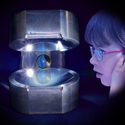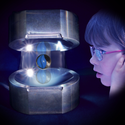Frozen light in a cavity
The ancient Greek philosopher Zeno of Elea introduced a paradox: If at each instant during the time of flight of an arrow, the arrow does not change its motion, how can the arrow move at all? This paradox leads to the modern term called the quantum Zeno effect, whereby rapid, repeated measurements on a quantum system can inhibit its usual evolution. This occurs because these measurements are very likely to project the system back onto the initial state, in accordance with the measurement postulate of quantum mechanics.
The quantum Zeno effect has been observed in two-level systems. Now, Julien Bernu and colleagues of the Ecole Normale Supérieure and the Collège de France demonstrate this effect for the quantum harmonic oscillator by repeatedly observing the photon number in a cavity. The experiment, reported in Physical Review Letters, uses a microwave source with an extremely stable phase and a high-quality, superconducting cavity whose length is kept fixed by cryogenic cooling. The classical microwave light field is injected into the initially empty cavity. By repeatedly injecting the light pulses, the energy inside the cavity builds up and the field undergoes its usual evolution. However, if measurements are performed between successive pulses, the scenario changes. Instead, highly excited (Rydberg) atoms are sent into the cavity and are perturbed by the field without absorbing or emitting photons into the cavity. This perturbation to the Rydberg atoms is detected to acquire information about the number of photons in the cavity field and to produce the projective measurements between the microwave pulses for demonstrating the quantum Zeno effect.
This freezing of light in a cavity provides a potentially useful way to control and manipulate quantum states of light. – Sonja Grondalski





